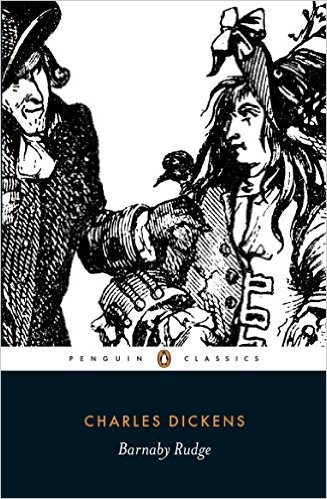I am grateful to the Morgan County Library of Versailles, Missouri, for acquiring, at my request, the Naxos audiobook of this novel narrated by Sean Barrett. The six-CD set enabled me to complete my tour of all Charles Dickens’s completed novels in less than a week’s worth of commuting.
Dickens’s fifth novel in order of publication, it was meant to have been published earlier, but due to disagreements with his publisher it only appeared in 1841, as a serial in weekly numbers of the author’s own journal, Master Humphrey’s Clock. Like the other works in what I like to call Dickens’s “weekly register,” it has the charm of being relatively short, direct, and concise. The characters and plot lines are few and tightly intertwined, and it never gives the reader the sense his monthly novels often give of leading them down tedious side routes and up inconsequential cul-de-sacs. It is one of only two historical novels Dickens wrote, the other being A Tale of Two Cities set in the revolutionary period of the late 1700s. And it is perhaps the last representative of its author’s immature period, with some of the same weaknesses that marred (sorry) Oliver Twist and The Old Curiosity Shop, which are about tied for my least favorite novel by Dickens. So while I personally would rank this book higher than both and perhaps even The Pickwick Papers, I can also understand why this may be Dickens’s least popular novel, the least often adapted for stage and film, the least influential on our culture.
Subtitled “A Tale of the Riots of Eighty,” it is primarily set amid and around the Gordon Riots of 1780 in which a certain Sir George Gordon led an anti-Catholic uprising that threatened Parliament, burned several churches, and ended with soldiers firing guns into a crowd. Several people were hanged or imprisoned in the aftermath, and the authorities were deeply embarrassed, and Dickens took his opportunity as a master of satirical wit to spatter his nation’s history of sectarian strife with shame and ridicule. This is a good thing. Another good thing is its positive depiction of a mentally challenged character. And the fact that the title character’s familiar, a talking raven named Grip, inspired Edgar Allan Poe’s famous poem “The Raven” proves this book was not without some influence. But everything else about it is entirely conventional and to be brutally frank, forgettable.
Dickens almost entirely wasted the opportunity to make Grip an ominous figure, a figure of omen. The bird says, “I’m a devil,” but it isn’t one. Dickens cheated idiot-hero Barnaby out of the chance to be a more complex and dynamic character or to suffer a movingly tragic fate like that of Sydney Carton in A Tale of Two Cities. And Dickens couldn’t resist using such a serious historical subject as a backdrop for not one but two chaste romances that come across as all the more trivial because the male heroes scarcely appear between the opening act and the close. They simply, suddenly appear at the moment of greatest crisis for the young heroines, and the resolution of their love stories is so perfunctory that it is hard to care about them any more than Dickens seems to have done.
What this book is, at its most interesting, is a depiction through the eyes of fictional (or at least fictionalized) persons of a scene of historical interest and a character study of three men under the suspense of awaiting their execution. The suspense pays off nicely, and Barnaby manages to get in at least one line that I think is worth adding to everyone’s quiver of literary quotes (“Hugh, we shall know what makes the stars shine now!”) If you hear it performed by a good reader, as I did, you may hear passages that make you laugh and even a few that give you a lump in your throat. But mostly, I felt grateful that the last Dickens novel I had yet to read was short and quickly gotten through. A Tale of Two Cities, which left me awestruck and emotionally devastated, was still 18 years in the future when this book came out. Believe me, I appreciate the difference 18 years can make.
Charles Dickens’s wiki page
Recommended Ages: 13+

